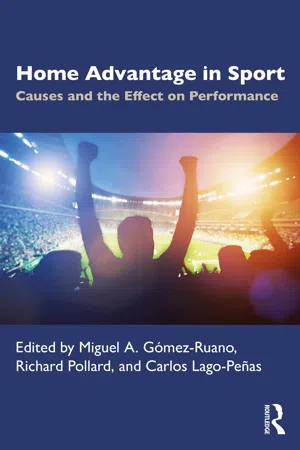
Home Advantage in Sport
Causes and the Effect on Performance
- 336 pages
- English
- ePUB (mobile friendly)
- Available on iOS & Android
Home Advantage in Sport
Causes and the Effect on Performance
About this book
This is the first book exploring the concept of home advantage (HA), the well-known beneficial effect that players and teams derive from performing at home in all sports throughout the world. Despite the fact that the existence of HA dates back to the origins of organized sport in the late 19th century, its root causes and how they operate and interact with each other are still unclear and remain the topic of intense research involving many disciplines, all with the potential objective of improving team and individual performance.
This book covers a broad review of HA divided into three different sections: (i) Section 1 focuses on the theory of HA in sport (the concept of this phenomenon, its quantification, and factors supposedly associated with the HA are explored; (ii) Section 2 analyses the effects of HA in sports related to both male and female athletes, in relation to tactics and strategies, fans, referees, travel, situational variables and the home disadvantage; and (iii) Section 3 studies the HA as it applies to specific sports worldwide such as outdoor sports (football, rugby, cricket, and Australian Football), indoor sports (basketball, futsal, handball, water polo and volleyball), US professional sports, individual sports, racket sports, combat sports, minor sports, disabled sports and the Olympic Games.
This book has been written in cooperation with top leading experts in this field worldwide. The book offers a better understanding of the HA effect for MSc and PhD students, athletes, coaches, performance analysts, sport psychologists, sociologists, sport scientists and sport journalists.
Frequently asked questions
- Essential is ideal for learners and professionals who enjoy exploring a wide range of subjects. Access the Essential Library with 800,000+ trusted titles and best-sellers across business, personal growth, and the humanities. Includes unlimited reading time and Standard Read Aloud voice.
- Complete: Perfect for advanced learners and researchers needing full, unrestricted access. Unlock 1.4M+ books across hundreds of subjects, including academic and specialized titles. The Complete Plan also includes advanced features like Premium Read Aloud and Research Assistant.
Please note we cannot support devices running on iOS 13 and Android 7 or earlier. Learn more about using the app.
Information
SECTION III
Home Advantage Applied to Specific Sports
17
HOME ADVANTAGE IN SOCCER
Are Goals Just Before Half-Time Worth More? Are There Psychological Goals in Soccer?
Three potential explanations for the non-positive effect of scoring just before half-time on full-time achievement were offered by Baert and Amez (2018): (1) a home team that scores a goal just before half-time may (unconsciously) relax a bit and go into the break with a feeling of having accomplished something; (2) scoring just before half-time may backfire on the mental status of the home team and thereby affect subsequent performance negatively; (3) and the emotion of a goal just before half-time may change the plan and lead to important changes in the way many teams play, with home teams probably playing more defensively in the second half compared with the first half.
| Half-time result | Goal home team between start of minute 45 and half time | Red card in the first half for home team | Home team final result |
|---|---|---|---|
| 0−0 | YES | YES | Lost |
| 1−0 | NO | NO | Won |
| 1−0 | YES | NO | Won |
| 1−0 | YES | YES | Won |
| 2−0 | NO | NO | Won |
| 2−0 | YES | NO | Won |
| 2−0 | YES | YES | Lost |
| 1−1 | NO | NO | Draw |
| 1−1 | YES | NO | Lost |
| 1−1 | YES | YES | Lost |
| 1−2 | NO | NO | Lost |
| 1−2 | YES | NO | Lost |
| 1−2 | YES | YES | Lost |
Is There a Second Leg Home Advantage Effect in a Two-Stage Knock-Out Competition?
Table of contents
- Cover
- Half Title
- Title Page
- Copyright Page
- Table of Contents
- List of Figures
- List of Tables
- List of Contributors
- Section I Theory of Home Advantage in Sports
- Section II Effects of Home Advantage in Sports
- Section III Home Advantage Applied to Specific Sports
- Index